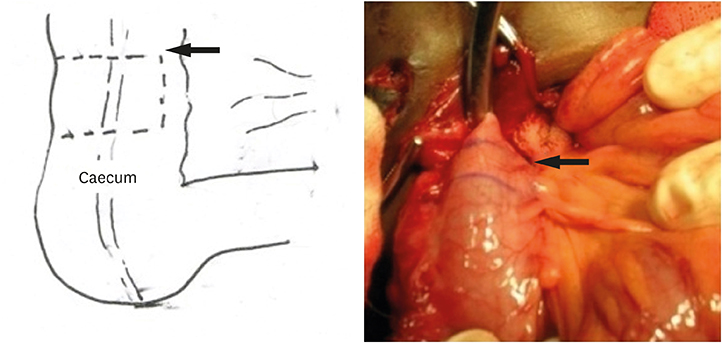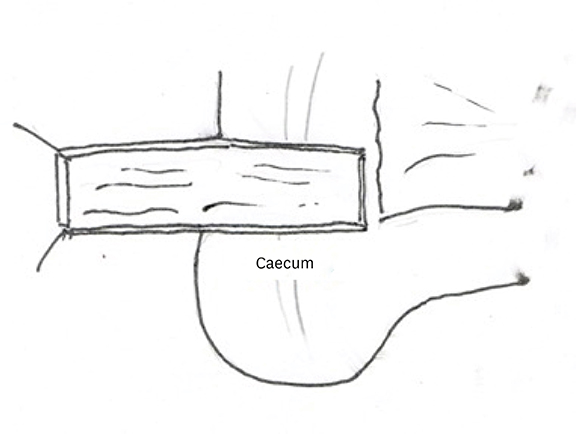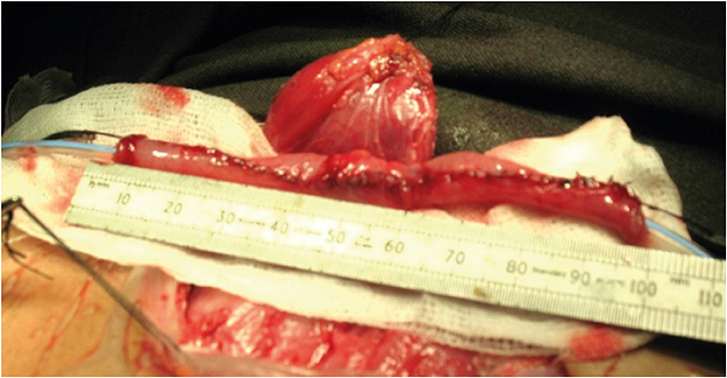Adv Pediatr Surg.
2019 Jun;25(1):1-6. 10.13029/aps.2019.25.1.1.
Feasibility and Early Outcomes of Continent Catheterizable Stomas Using Cecal/Colon and Ileum for Children with Fecal Incontinence as an Alternative to Appendicular Malone Antegrade Continence Enema
- Affiliations
-
- 1Department of Pediatric Surgery, Indira Gandhi Institute of Child Health, Bangalore, India. drshaileshpgi@gmail.com
- KMID: 2451061
- DOI: http://doi.org/10.13029/aps.2019.25.1.1
Abstract
- PURPOSE
The introduction of Malone antegrade continence enema) in the management of children with fecal incontinence has brought remarkable improvement in patient care, Malone originally described appendix as a conduit and it has become widely accepted. However, surgeons are faced with situations where appendix is not available, the selection and creation of other conduit is always a challenge. We present our technique and experience with the use of alternative catheterizable conduits for antegrade continence enema (ACE).
METHODS
Retrospective review of children who underwent ACE procedure in our institution from March 2009 to January 2014. The details retrieved: indication, reason for non availability of appendix, type of conduit, complications and patient's satisfaction.
RESULTS
Five children were identified in whom the appendix was not available or suitable. In four children cecal/colon-based flap was used and in one child, ileal (Monti) segment was used to create a conduit. The mean follow-up was 3.2 years. All patients were satisfied with the procedure and no stenosis or loss of conduit was noted in the follow-up.
CONCLUSION
Continent catheterizable conduit for ACE can be accomplished with transverse tubularized intestinal segments and cecal/colonic flaps, with excellent outcome, irrespective of tissue used. Surgeon's preference and the patient's peculiar anatomy should determine the surgical technique to be used.
Keyword
MeSH Terms
Figure
Reference
-
1. Malone PS, Ransley PG, Kiely EM. Preliminary report: the antegrade continence enema. Lancet. 1990; 336:1217–1218.
Article2. VanderBrink BA, Cain MP, Kaefer M, Meldrum KK, Misseri R, Rink RC. Outcomes following Malone antegrade continence enema and their surgical revisions. J Pediatr Surg. 2013; 48:2134–2139.
Article3. Sinha CK, Butler C, Haddad M. Left Antegrade Continent Enema (LACE): review of the literature. Eur J Pediatr Surg. 2008; 18:215–218.
Article4. Casale AJ. A long continent ileovesicostomy using a single piece of bowel. J Urol. 1999; 162:1743–1745.
Article5. Imai K, Shiroyanagi Y, Kim WJ, Ichiroku T, Yamazaki Y. Satisfaction after the Malone antegrade continence enema procedure in patientswith spina bifida. Spinal Cord. 2014; 52:54–57.6. Chan DS, Delicata RJ. Meta-analysis of antegrade continence enema in adults with faecal incontinence and constipation. Br J Surg. 2016; 103:322–327.
Article7. Dolejs SC, Smith JK Jr, Sheplock J, Croffie JM, Rescorla FJ. Contemporary short- and long-term outcomes in patients with unremitting constipation and fecal incontinence treated with an antegrade continence enema. J Pediatr Surg. 2017; 52:79–83.
Article8. Weiser AC, Stock JA, Hanna MK. Modified cecal flap neoappendix for the Malone antegrade continence enema procedure: a novel technique. J Urol. 2003; 169:2321–2324.
Article9. Levitt MA, Soffer SZ, Peña A. Continent appendicostomy in the bowel management of fecally incontinent children. J Pediatr Surg. 1997; 32:1630–1633.
Article10. Kurzrock EA, Karpman E, Stone AR. Colonic tubes for the antegrade continence enema: comparison of surgical technique. J Urol. 2004; 172:700–702.
Article
- Full Text Links
- Actions
-
Cited
- CITED
-
- Close
- Share
- Similar articles
-
- Left Colonic Antegrade Continence Enema: Experience Gained from 19 Cases
- Management of Neurogenic Fecal Incontinence and Constipation in Myelodysplastic Children by Malone Antegrade Colonic Enema Procedure: Early Experiences
- The Antegrade Continence Enema Procedure Using Retubulized Sigmoidostomy
- The Results of Treating Fecal Incontinence with Antegrade Continence Enema (ACE)
- The Result of Antegrade Continence Enema for Fecal Incontinence Experience of Eighteen Patients with Menigomyelocele





